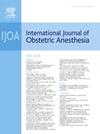Intraoperative pain during cesarean delivery: a qualitative concept elicitation study
IF 2.3
3区 医学
Q2 ANESTHESIOLOGY
引用次数: 0
Abstract
Background
Qualitative studies surrounding patient experiences of intraoperative pain during cesarean delivery (PDCD) are lacking. The primary outcome of this study was to identify themes that describe experiences of PDCD performed under neuraxial anesthesia from the patients' perspective. Secondary outcomes were to provide exemplar quotations for themes identified and summarize patient experiences.
Methods
This prospective qualitative study included semi-structured interviews of patients who delivered at Lucille Packard Children’s Hospital, Stanford, California, between 2023 and 2024. Consenting participants were English-speaking, 18–50 years old, who received a primary neuraxial anesthetic for CD of a live infant with a gestational age at time of delivery ≥25 weeks and reported PDCD on postpartum day 1 to 3. Recorded interviews occurred on postpartum day 1, 2 or 3, and patients were screened for post-traumatic stress symptoms and depression with PCL-5 and EPDS questionnaires during inpatient admission and at 6-weeks postpartum and referred to psychiatry services if indicated.
Results
Ten interviews were completed. Seven participants delivered via scheduled CD and three via intrapartum CD. Nine domains were proposed for the construct of PDCD: patient expectations, anesthesia care on the labor and delivery unit, interactions with staff, obstetric variables, anesthesia care in the operating room, patient impression of the anesthesia provider, testing of the block, maternal psychological state, and sensations during surgery. Four patients were referred to psychiatry services for follow up care.
Conclusions
These findings can help guide future research efforts designed to improve counseling, prevention and management of PDCD, and highlight the need to determine the long-term psychological impact of PDCD.
剖宫产术中疼痛:一项定性概念启发研究
背景:关于剖宫产(PDCD)患者术中疼痛经历的定性研究尚缺乏。本研究的主要结果是从患者的角度确定描述在轴向麻醉下进行PDCD的经历的主题。次要结果是为确定的主题提供范例引用并总结患者经验。方法本前瞻性定性研究包括对2023年至2024年间在加州斯坦福市露西尔·帕卡德儿童医院分娩的患者进行半结构化访谈。同意的参与者为英语,18-50岁,在分娩时胎龄≥25周的活婴接受初级轴向麻醉治疗CD,并在产后1至3天报告PDCD。在产后第1、2或3天进行记录访谈,并在住院期间和产后6周使用PCL-5和EPDS问卷对患者进行创伤后应激症状和抑郁筛查,如有必要,转介精神病学服务。结果共完成10次访谈。7名参与者通过计划CD分娩,3名通过产时CD分娩。PDCD的构建涉及9个领域:患者期望、分娩单位的麻醉护理、与工作人员的互动、产科变量、手术室的麻醉护理、患者对麻醉提供者的印象、阻滞测试、产妇心理状态和手术过程中的感觉。4名患者被转介到精神科接受后续治疗。结论这些发现有助于指导未来的研究工作,旨在改善PDCD的咨询,预防和管理,并强调需要确定PDCD的长期心理影响。
本文章由计算机程序翻译,如有差异,请以英文原文为准。
求助全文
约1分钟内获得全文
求助全文
来源期刊
CiteScore
4.70
自引率
7.10%
发文量
285
审稿时长
58 days
期刊介绍:
The International Journal of Obstetric Anesthesia is the only journal publishing original articles devoted exclusively to obstetric anesthesia and bringing together all three of its principal components; anesthesia care for operative delivery and the perioperative period, pain relief in labour and care of the critically ill obstetric patient.
• Original research (both clinical and laboratory), short reports and case reports will be considered.
• The journal also publishes invited review articles and debates on topical and controversial subjects in the area of obstetric anesthesia.
• Articles on related topics such as perinatal physiology and pharmacology and all subjects of importance to obstetric anaesthetists/anesthesiologists are also welcome.
The journal is peer-reviewed by international experts. Scholarship is stressed to include the focus on discovery, application of knowledge across fields, and informing the medical community. Through the peer-review process, we hope to attest to the quality of scholarships and guide the Journal to extend and transform knowledge in this important and expanding area.

 求助内容:
求助内容: 应助结果提醒方式:
应助结果提醒方式:


